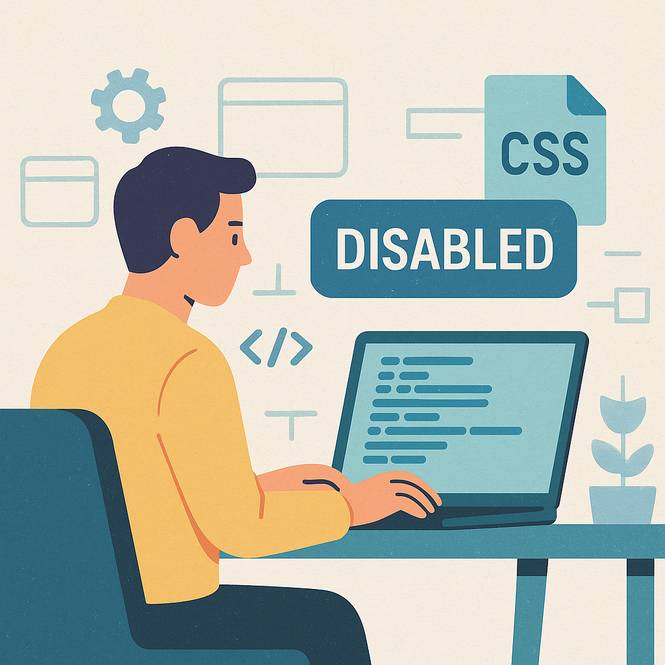
Disabled HTML CSS buttons play a crucial role in modern web design by guiding user interaction and stopping invalid submissions. Web designers use them in forms, when loading code, and conditional workflows.
If you've ever clicked a button on a website and nothing happened, chances are you've encountered a disabled button.
It's an actively disabled button made to not be clickable to steer user behavior, prevent errors, or deliver an optimized experience.
As a new coder, you may not even notice them, but disabled buttons permeate the web design community, operating quietly behind the scenes to shape how we interact with websites and apps.
In this piece, we will discuss where disabled buttons are found, why they are important, and how you can search for them while browsing your way around the web.
Where You'll Usually Find Disabled Buttons
Disabled buttons are a standard of web design, employed intentionally to manage user behavior. Let's discuss where you'll usually find them:
1. Contact and Sign-Up Forms
Ever attempted to fill out a contact form and not fill in the complete fields? The "Submit" button is usually grayed out until you fill in all the fields, such as your name, email, or message.
This helps prevent people from posting incomplete or wrong information. For instance, for a newsletter sign-up form, the "Join" button can be grayed out until you provide an email address that is valid.
2. Login Pages
On login pages, the "Sign In" button will usually be disabled until you've entered both a username and a password. This will prevent you from submitting blank or incorrect credentials, avoiding error messages and servers' overload.
Sites such as Netflix or Gmail do this so that you fill all required fields first.
3. E-Commerce Checkout Processes
When shopping online, disabled buttons are an essential part of preventing expensive mistakes. For example, on Etsy or Amazon, the "Place Order" button may be disabled until you choose a shipping address or payment method.
This prevents you from accidentally placing an incomplete order, which would lead to delays or confusion.
4. Admin Panels and Dashboards
On WordPress or Google Analytics programs, disabled buttons are the standard in admin sections. An instance is a "Save Changes" button, which can remain disabled until you change something actually with an option.
This avoids unnecessary submission and keeps the system running at a smooth speed.
5. Mobile Apps and SaaS Tools
Disabled buttons are not only found on websites but also on mobile apps and software-as-a-service (SaaS) applications.
On apps such as Trello or Slack, buttons such as "Create Task" or "Send Message" can be disabled until you enter required information, such as a task title or message text.
This encourages users to complete the details before they can activate.
What Happens When They're Missing
Without disabled buttons, the web and applications become messy. This is what can happen if developers omit them:
Duplicate Orders: Suppose you repeatedly click “Buy Now” on an online shop’s webpage, as the website didn’t disable the button after your first click.
You can have several duplicate orders, wasting your time and unnecessary work for customer service.
Invalid Submissions: Without disabled buttons, users can submit forms with empty or invalid information, causing errors.
For example, a login page that takes an empty password field might overload servers with incorrect requests or confuse users with ambiguous error messages.
Bad User-Experience: Disabled buttons give users visual feedback, such as grayed-out formatting, to inform them of what is clickable and what is not.
Without them, users may become confused or disoriented, asking themselves why their actions are achieving nothing.
Disabled buttons allow developers to have a neater, more intuitive experience that avoids errors and maintains transparency in interactions.
Encourage Observation
Now that you know where disabled buttons show up, study the places and programs you visit regularly more closely. The next time you're on a place like Twitter, Spotify, or your favorite online store site, study the buttons.
Observe how the "Tweet" button won't enable until you've typed something, or how a "Checkout" button won't click until you've put something into a cart.
These little things are the product of careful web design, and noticing them will allow you to see how developers use disabled HTML CSS button to manage user interaction.
Begin learning now, and make your buttons behave similarly! Check out the complete tutorial here: Deactivating an HTML Button and start working on making your disabled buttons right away!
Final Words
Disabled buttons are a simple but powerful tool in web design; and as a beginner in coding, you can learn to code one yourself.
By using HTML attributes like disabled and styling it with CSS, you can make buttons that effectively assign an action to a user.